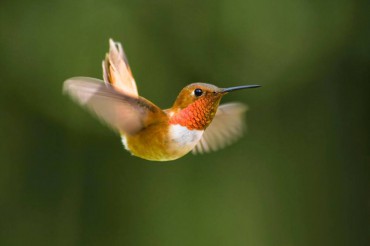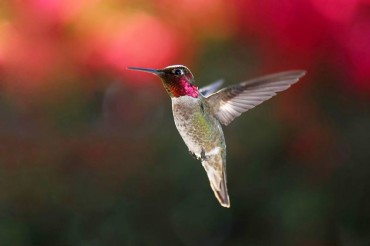
Even before March arrived hummingbird enthusiasts were keeping an eye out for the first returning Rufous hummingbird. March is the month when these tiny bits of feather and bone return to the Pacific Northwest. They have spent the winter in the Southwest United States and Mexico.
Rufous hummingbirds are the most adventurous members of this family. Their spring migration journey takes them from southern wintering grounds to as far north as Southeast Alaska. No other hummingbird travels as far north to nest.
The rufous derives its name from the male bird’s reddish-brown body. The female has a touch of light rufous on her flanks but the rest of her coloring consists of a green back and pale undersides.
It is the male that gets all the attention. In addition to his rufous body, he has an orange-red throat that can flash from gold to red and even to black. The shade of color depends on how the sun highlights his throat feathers.
The male birds arrive first. They will establish their territories while waiting for the females. Then a swift courtship takes place.
When it is over, the male looks for greener pastures and the female builds her nest. She will lay two small eggs about the size of a person’s little fingernail. She broods the eggs and raises the babies by herself. This is the way of the rufous hummingbird and she isn’t alone.

Anna’s hummingbirds are relatively new in this part of the Pacific Northwest. The male Anna’s has a rose-red crown and throat and a green body. Slightly larger than the rufous, this bird has been expanding its northern boundaries for several decades.
They were originally recorded only as far north as Northern California. It has taken 20 to 30 years for them to reach the population numbers now current in Western Washington. There have been mixed feelings among humans as well as the rufous, who once had this territory to themselves.
Northwest winters are mostly mild but freezing temperatures hit the region during a normal winter. Hummingbird feeders were always taken down after the birds headed south in late summer.
The Anna’s hummingbirds turned everything upside down when their growing winter numbers began showing up in yards throughout the lowlands. Habits changed. Now the challenge is to keep the syrup in the feeders from freezing.
Hummingbird lovers will get up before daylight to put out the feeders they took in the night before. Others install their feeders near an outdoor light, where the heat keeps the syrup liquid. Some even wrap hand warmers around their feeder.
The ways to keep the feeders from freezing continue to grow and challenge Northwest residents. In the meantime, the hummingbird population also continues to grow.
The Anna’s and the rufous will nest in the same yard because the Anna’s start earlier. There isn’t the territorial challenging that would take place if they nested at the same time.
Feeders are only one way to attract hummingbirds. Flowers and other plants are the most popular during the breeding season. They not only produce the nectar the birds want. They attract the microscopic insects that make up the greatest part of the bird’s diet. They need that protein.
Nurseries offer a growing selection of hummingbird-attracting plants and careful planning can mean flowers for hummingbirds almost year round.
Winter-blooming plants as well as those that flower during the warmer months are readily available. Red is the most popular color when attracting hummingbirds and tubular-shaped flowers are irresistible.
March may be the month when thoughts of hummingbirds are in many people’s minds but some hummingbirds spent the winter with us.

























